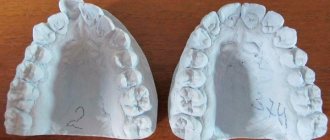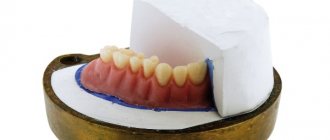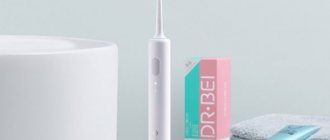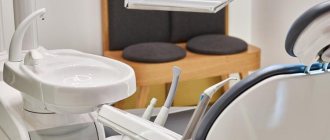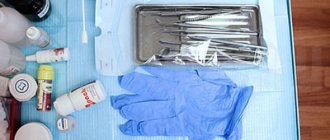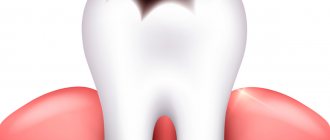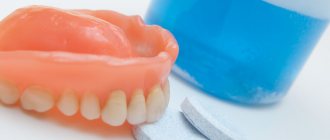In this article we will look at what types of impression materials there are for impressions.
The quality of the material, as well as the competence of the dentist to whom a person comes for treatment, is a very important factor in the process of making casts or impressions of the dentition. A cast or impression is a negative image of the jaw in a convex shape. In other words, this is a display of the teeth necessary to create a prosthesis, as well as other jaw areas.
Purpose and use in dentistry
The most popular area of application for impression materials is dental prosthetics. Specialists in making impressions are orthopedic surgeons and orthodontists. The terms "cast" and "impression" are usually used interchangeably. But someone thinks that they refer to products that are made from various materials.
Impression masses are used for certain indications, depending on the state of human health, the characteristics of the pathological state of the soft tissues of the oral cavity and dentition, and the design of the prosthesis or apparatus being manufactured.
Advantages and disadvantages
The advantages of the drug include:
- high strength combined with mass elasticity;
- different range of material adhesion , which allows you to choose the product that is most suitable in each specific situation;
- high stability of initial parameters;
- rapid absorption of liquid>;
- ease of mixing the components of the product;
- minimal content of dust fragments , which eliminates the risk of inhaling dust pieces during the manipulation process;
- long shelf life in closed packaging - at least 5 years from the date of manufacture;
- a special composition that minimizes the risk of subsequent shrinkage of the mixture after hardening;
- does not spread in the patient’s mouth;
- has a pleasant taste and does not irritate soft mucous tissues;
- all substances included in the drug are made from natural ingredients and are safe for human health;
Allergic reactions of the body are a phenomenon that is isolated in nature and is classified as an exception.
Alginate-containing powders also have disadvantages:
- too large a proportion of water in the composition is fraught with long processes of hardening of the mixture;
- excessively rapid dissolution of the mass can, on the contrary, accelerate these processes;
- if the composition is kneaded without observing the technology and the required proportions, then over time it will begin to crumble;
- any discrepancy with the instructions for use will lead to a violation of the structural content of the material and a violation of its integrity in the shortest possible time.
Gypsum
Gypsum is an irreversible raw material - it is produced by firing natural gypsum. The sifted raw materials are mixed with water before making the impression and the gypsum quickly hardens, which makes it possible to create clear impressions. This material has the following disadvantages: poor grinding - low quality - does not allow the mixture to harden quickly; high probability of breakage due to fragility; Not all substances may be used when detaching the impression and model (for example, those containing fat). It is very important to follow the rules for storing it in a dry place. During long-term storage, lumps begin to form in gypsum powder.
Advantages of gypsum:
- affordable price;
- absence of unpleasant taste and smell;
- obtaining an accurate drawing;
- unstickiness;
- no negative impact on the mucous membrane of the oral cavity and tissues around the teeth.
Curing process and curing reaction
In the process of interaction with water of the powder mixture, a chemically active reaction begins, the result of which is strong transverse adhesion of polymer chains and the formation of an impact-resistant, three-dimensional structure.
Such connections cannot be broken by trying to redirect the structure to its original linear state.
Consequently, these hardening processes can be classified as irreversible, and this drug can be used once and only according to a sequential scheme: mixture - gel mass - chemical processes.
The curing reaction proceeds as follows . Calcium sulfate dihydrate supplies calcium ion elements for cross-linking processes , due to which the sol is transformed into a gel consistency. The ions begin to be partially released from the aqueous base.
The working period and time frame for final hardening of the composition are determined by the rate of formation of ions and their tendency to form transversely.
Accelerated dissolution of sulfate substances could produce a composition unsuitable for working hours. To prevent these phenomena, sodium phosphate was introduced into the drug component . It has a sedative effect on the explosive primary rate of formation of calcium ions.
In such a situation, phosphate performs an inhibitory function ; its concentration can regulate the hardening speed and modify the impression material.
The processes of bringing products into a solid state entail a change in the acidic background in the oral cavity.
As it hardens, this indicator drops, which helps to give a visual assessment of the action of the described processes and allows you to regulate the time of dental work with the material .
Zinc oxide eugenol pastes
Zinc oxide eugenol pastes are another irreversible material. Water and zinc eugenolate are mixed in them and the mixture after this reaction acquires plasticity. Dentists use them for edentulism (partial or complete), that is, the absence of teeth. This mixture can be preferred because it is easy to separate from the model, sticks quickly and has high definition. However, it is very important to mix it correctly, since pastes can break during breeding due to their fragility.
What other impression materials are there?
Thermoplastic masses
Reversible solids include thermoplastic masses: stearin, rosin, paraffin, gutta-percha, stens, wax, Kerr mass, Weinstein mass. These materials have a distinctive property - they become plastic when heated.
In this case, the softening of these substances should be carried out at a temperature of no more than 60 degrees Celsius, otherwise you can burn the oral cavity. Properly heated mass for taking impressions is perfectly adjusted during processing, but the optimal temperature is the human body temperature. Another essential property is homogeneity. In addition, a good mass of this type will not become sticky and will be safe for health at high temperatures.
Alginate impression mass
Sodium alginic acid, or alginate, is a powder that is miscible with water. To get the right mixture, you need to strictly adhere to the proportions of water and powder. Alginate has several disadvantages: a large amount of water will cause slow hardening; a poorly mixed mixture will crumble. It is also important to strictly observe the mixing ratio, for which it is better to use packaged bags of powder to get an impression. With the correct actions during the mixing process, the impression is obtained quickly and easily, separates well from the model, and retains the resulting shape for a long time.
Is there a silicone impression compound?
special instructions
Mixing materials is a very important step in taking an impression.
- It is necessary to strictly observe the ratio of components specified in the instructions. Ignoring this requirement will lead to a violation of the consistency of the impression mass and, as a consequence, to a poor-quality impression.
- To measure powder and water, use the dosing containers included in the package.
- The mixing times indicated in the instructions assume the use of distilled water at a temperature of approximately 23 °C . If hard water or higher temperatures are used, the processing time should be reduced.
Impression elastomer materials
Impression elastomer substances in the field of dentistry are divided into thiokol, polyester and silicone. There are two types of silicone impression compounds: additive and polycondensation.
These materials are based on basate paste, which reacts with a catalyst, hardening occurs within three to four minutes. An additional layer is applied on top to get all the protrusions, recesses and contours. Such raw materials are good to use to create an initial impression, a touch-up composition or a custom tray. Like other substances, it has a number of advantages: moderate cost; high accuracy; accelerated adhesion, that is, the adhesion of bodies of various kinds; lack of taste and smell. However, there are also disadvantages: it will take two hours to make the model; the mixture is capable of absorbing moisture and in this case becomes of poor quality; the model may shrink; The product is capable of changing its shape under pressure.
This is confirmed by the instructions for the impression material.
How to work with the material to make an impression?
Of course, you can make a cast yourself. But it is not recommended to use it to form a prosthesis, since a person without special training is unlikely to be able to make an accurate impression of the required part of the jaw.
Algorithm of actions:
- Selecting a spoon for applying the mixture, which are divided into groups (universal and special, plastic and metal). It is better to use metal ones. This ensures that they will not become deformed while the material is being applied to the patient's teeth. You also need to pay attention to the size of the spoon. It is desirable to have thickened sides with a total width of 5 mm larger than the tooth.
- The choice of the type of alginate mass depends on the scale of the work, as well as the degree of damage to the jaw.
- The mixture is prepared in strict accordance with the instructions. The ingredients are distributed using measuring containers. Incorrect use of materials will affect the hardening time of the mass, as well as its ductility. When kneading, use a rubber bowl.
- Applying the mass. An impression is made not only of the jaw where the prosthesis will be installed, but also of the opposite side. The material is also applied to adjacent teeth in order to calculate the distance between the teeth and the maximum size of the future prosthesis. For the upper jaw, the inner part of the tooth is covered first, and for the lower jaw, the outer part is covered.
- Removing the finished print is done in one strong movement to prevent deformation.
Alginate impression mass, ready-made impressions
It is best to use the impression to make a prosthesis during the first 30 minutes. But if transportation is necessary, the impression is wrapped in a damp cloth and placed in a plastic case.
Polyester masses
Polyester masses are understood as pastes with a medium consistency. They are based on polyesters with low molecular weight. Then the impression mass is filled with silica, glycol ether phthalate gives it elasticity. Then it is packaged in tubes (or tubes).
Advantages of these masses:
- versatility – wide range of use in orthopedics;
- secondary use when creating a model;
- high print accuracy; fast hardening;
- long service life - its density remains longer than a month;
- sufficient strength;
- the impression can be sterilized.
However, this case also has its drawbacks: the difficulty of removing it from the patient’s mouth and the high cost of the substance.
Disinfection
Prevention of infectious diseases is an important stage in dentistry. During production, oral bacteria are exposed to the impression. In the future, they will end up on the prosthesis itself, so the impressions must be disinfected.
Disinfection methods are divided into three groups:
- The first group is immersion methods, immersing the impression in a special disinfectant solution. When disinfecting impressions using the immersion method, products containing active substances are used that inhibit the growth of bacteria, viruses and fungi. Suitable means for disinfection are a 2-2.5% buffer solution of glutaraldehyde and the ready-made preparation “Glutarex”.
- The second group is physical methods. This is exposure to high or low temperatures or ultraviolet radiation, as well as the method of ultrasonic treatment.
- The third group is methods of spraying a special composition over products.
Reference . It has been established that for high-quality disinfection it is better to combine immersion in a disinfectant solution and ultrasound.
After disinfection, the impressions are washed with water for 0.5 minutes. on each side or immerse in a container of water for 5 minutes, then air dry.
Instructions for taking impressions
The doctor first examines the oral cavity and, if necessary, treats or removes individual teeth. When the patient has chosen a design, further preparations are made for taking an impression. The specialist injects a solution for pain relief and prepares the bone organs of the oral cavity for making an imprint. He then dries his mouth with cotton swabs. After this, the doctor needs to knead the material from which the impression will be made. An impression can be taken in different ways. One of them consists of the following steps: an adhesive substance is spread on a spoon, then a thick paste, and an impression of the teeth is immediately taken.
This is all done before preparing the elements, so that there is room for the corrective composition. After preparing the teeth, expansion occurs in the recesses of the supporting gum elements. It is there that you need to insert retraction threads, which are impregnated with a vasoconstrictor composition. To stop bleeding from the gums and fix the threads, place a cotton cylinder in the prepared element. At the end, the patient closes his mouth so that the grooves between the gums and teeth do not bleed. The doctor removes the paste from this impression and fills it with a new composition. After this, the impression is sent a second time to the oral cavity and is now completely dry.
Main characteristics of SPEEDEX (Spidex):
- — Accurate reproduction of details
- - Low shrinkage
- — Time for casting a model — up to 72 hours
Manufacturer: Switzerland
"SPEEDEX" - silicone impression material for use in dentistry
"SPEEDEX putty" - mass for the base layer,
"SPEEDEX light body" - mass for the corrective layer
Material type
Polysiloxane, K-type, silicone elastomer of high (SPIDEX putty) or low (SPIDEX light body) viscosity.
Indications SPEEDEX (Spidex)
- — taking impressions using the two-layer impression method
- — taking impressions using the single-phase two-layer impression technique
- — taking impressions using a copper ring
- — impressions for making diagnostic and demonstration models
Contraindications SPEEDEX (Spidex)
If the material is used in accordance with the instructions, there are no known contraindications.
Side effects
Polysiloxanes have very high biocompatibility and to date no side effects have been observed from them either in patients or medical staff. Impression materials are designed to harden in the mouth, however, they should not remain in the mouth for more than twice the working time. Care must be taken to ensure that material residues do not remain in the interdental spaces and gingival grooves. Before taking an impression, all undercuts must be closed.
If catalyst gets into your eyes, rinse them with plenty of running water and consult an ophthalmologist.
Impression trays
It is recommended to use rigid perforated impression trays. For best adhesion, it is recommended to apply a thin layer of Coltene Adhesive to the spoon.
Dosage and mixing
First layer
The main impression material SPEEDEX (Spidex) is dosed using a measuring spoon. Apply a full measure (after removing excess so that there is no “slide”) of material onto your palm. The SPEEDEX catalyst is dosed in such a way that the length of the catalyst portion squeezed out of the tube corresponds to the small (upper) diameter of the truncated cone made of material that appears in your palm. Mix with your fingers until a uniform shade is obtained, but for at least 30 seconds. The material is ready for making an impression.
Second layer
The material for the second layer of the impression is mixed using a spatula on glass or paper. The correct ratio of the corrective mass SPEEDEX (Spidex) and the catalyst SPEEDEX (Spidex) is achieved by squeezing portions of the same length from the tube with the catalyst and from the tube with “SPEEDEX Light Body”.
Remaining material outside the mouth takes much longer to harden, but before removing the impression from the mouth, it is necessary to check intraorally whether the material has hardened.
Attention:
To ensure good adhesion of the layers, the first impression must be thoroughly washed and dried before applying the corrective mass.
If hydrogen peroxide was used for disinfection, it is recommended to rinse it thoroughly with water to prevent the formation of bubbles
Model casting
The ideal time for casting models is 30 minutes after taking the impression. Surface tension will be reduced and results will be most accurate if the impression is treated with detergent and rinsed with clean water. Coltene impression materials are compatible with all types of dental plasters, epoxy resins and polyurethane.
Speedex light body surface activated.
Impression material.
SPEEDEX (Spidex) is a lightweight silicone-based impression material for use in dentistry.
Polysiloxane, condensable type silicone elastomer, low viscosity. Base: dark blue; Universal activator catalyst (separately): green, ISO 4823, type 3, low consistency.
Indications for use of SPEEDEX (Spidex)
- — Wash material for putty-wash impression-taking technique
- — Syringe material for simultaneous mixing technique.
- — Impression material for relining clinical time (normal dose)
Contraindications SPEEDEX (Spidex)
When using the material according to the instructions, no contraindications were found.
Side effects/reactions
Polyxyloxane has excellent biocompatibility, and to date, no adverse effects of the material on either patients or medical personnel have been identified. The impression material is designed to harden in the patient's mouth, but the time the material remains in the mouth should not exceed twice the hardening time. Although the material has a fairly high tensile strength, be careful not to allow impression material to remain in interdental spaces or sulci. If necessary, undercuts should be isolated before impressions are taken.
If the Universal Activator catalyst gets into your eyes, rinse them with plenty of water and consult an ophthalmologist.
Spoons.
Standard rigid or customized impression trays. To ensure maximum adhesion, we recommend applying a thin layer of coltene. Possesses adhesion to all types of impression trays.
Squeeze out equal amounts of SPEEDEX base and SPEEDEX catalyst.
Always measure out the required amount of universal activator first for best results.
Close the tube immediately after use!
Overdosing or underdosing: Too much or too little material can speed up or slow down the curing time.
Even if you choose the minimum hardening time for the material, this time should be enough for the correct application of the material and installation of the spoon in the desired position.
Take one of the ingredients with a spoon and spread it evenly over the other material.
Taking impressions.
Insert the spoon and set it to the desired position (2-3 seconds). Hold without pressing until the material hardens completely. It takes much longer for excess material to harden at room temperature. Therefore, it is necessary to check the degree of hardening of the material intraorally. Intensive mixing, elevated temperatures or an overdose of catalyst accelerate the hardening process; Low temperature and insufficient amount of universal activator slow down hardening.
Important note: To ensure complete adhesion to the wash material, primary impressions must be thoroughly rinsed and dried before further use.
When using H2O2 or hydrogen peroxide for disinfection, it is recommended to rinse the impression thoroughly with water to avoid the formation of bubbles.
Disinfection
The impression should be rinsed under running cold water after removal from the mouth. Soaking for 30 seconds in liquid disinfectants such as 2% glutaraldehyde (acid), 0.5% sodium hypo-chloride, 0.1-1.5% providone-iodine (halogenated phenol) or 0.13% glutaraldehyde (neutral) will not affect shape and size of the casts. Acrylic spoons must be protected from water sorption.
Making models
The optimal time is from 30 minutes to 70 hours from the moment the impression is taken. Thanks to the excellent resistance to deformation, casting of models is possible within 7 days from the moment of taking the impressions without any changes in dimensions. Surface tension can be reduced and model making easier if the impression is quickly treated with detergent and then rinsed thoroughly with clean, warm water. Coltene impression materials are compatible with all types of dental plaster (eg Fuji-rock, Vel-mix), epoxy resin and polyurethane.
Electro-spraying
Compatible with all manufactured copper plating and silver plating baths.
Cleaning spoons
The impression can be separated from the impression tray with a blunt instrument. Universal commercial solvents or light benzene will dissolve coltene adhesive. These solvents can only be used in a well-ventilated area. The spoons can be washed and disinfected in the usual way.
Shelf life
SPEEDEX (Spidex) retains its qualities at least until the expiration date indicated on the containers. The material should be stored in tightly closed containers at a temperature of 15-23°C and a relative humidity of 50%. Casts should be stored at normal room temperature away from exposure to sunlight and elevated temperatures.
Marking
The expiration date (year, month) and article number are indicated on the cartridge and packaging. Technical data ISO 4823:1992. Measurements were taken at room temperature 23 C and relative humidity 50%.
"Speedex putty"
SPEEDEX (Spidex) is a silicone-based impression material intended for use in dentistry.
Polysiloxane, condensable silicone elastomer, high viscosity impression material. Base: light gray; Catalyst universal activator (separately): green, ISO 4823, type 1, high density.
Indications for use of SPEEDEX (Spidex)
- — Initial casts using putty-wash technique
- — Impression material for the simultaneous mixing technique
- — Finding material for copperband impression-taking techniques
- — Casts for educational models, orthodontic models, matrices, protective isolation of teeth during flasking of dentures
Contraindications SPEEDEX (Spidex)
When using the material according to the instructions, no contraindications were found.
Impression trays
Standard hard spoons. To ensure maximum adhesion, we recommend applying a thin layer of coltene. Possesses adhesion to all types of impression trays.
Dosing
Measure out the required amount of putty material using a measuring stick (remove any excess material). Distribute a measured amount of material onto your palm. When scooping material onto a spoon, lower it into the mixture only once. Squeeze out equal amounts of base and catalyst. It is necessary to close the tube with Universal activator catalyst immediately after use.
Overdosage or insufficient amount of material
Too much or too little material can increase or decrease curing time.
Even if you select the minimum curing time for the material, this time should be sufficient for the correct application of the material and installation of the tray in the desired position.
Knead the material with your fingers and knead vigorously until the color is completely uniform, about 30 seconds. When mechanically mixing, follow the manufacturer's instructions for using the machine.
Taking impressions.
Insert the spoon and set it to the desired position (2-3 seconds). Hold without pressing until the material hardens completely. It takes much longer for excess material to harden at room temperature. Therefore, it is necessary to check the degree of hardening of the material intraorally. Intensive mixing, elevated temperatures or an overdose of catalyst accelerate the hardening process; Low temperature and insufficient amount of universal activator slow down hardening.
Important note: To ensure complete adhesion to the wash material, primary impressions must be thoroughly rinsed and dried before further use.
When using H2O2 or hydrogen peroxide for disinfection, it is recommended to rinse the impression thoroughly with water to avoid the formation of bubbles.
Disinfection
The impression should be rinsed under running cold water after removal from the mouth. Soaking for 30 seconds in liquid disinfectants such as 2% glutaraldehyde (acid), 0.5% sodium hypo-chloride, 0.1-1.5% providone-iodine (halogenated phenol) or 0.13% glutaraldehyde (neutral) will not affect shape and size of the casts. Acrylic spoons must be protected from water sorption.
Making models
The optimal time is from 30 minutes to 70 hours from the moment the impression is taken. Surface tension can be reduced and model making easier if the impression is quickly treated with detergent and then rinsed thoroughly with clean water. Coltene impression materials are compatible with all types of dental plaster (eg Fuji-rock, Vel-mix), epoxy resin and polyurethane.
Electro-spraying
Compatible with all manufactured copper plating and silver plating baths.
Cleaning spoons
The impression can be separated from the impression tray with a blunt instrument. Universal commercial solvents or light benzene will dissolve coltene adhesive. These solvents can only be used in a well-ventilated area. The spoons can be washed and disinfected in the usual way.
Shelf life
SPEEDEX (Spidex) retains its qualities at least until the expiration date indicated on the containers. The material should be stored in tightly closed containers at a temperature of 15-23°C and a relative humidity of 50%. Casts should be stored at normal room temperature away from exposure to sunlight and elevated temperatures.
Marking
The expiration date (year, month) and article number are indicated on the cartridge and packaging. Technical data ISO 4823:1992. Measurements were taken at room temperature 23*C and relative humidity 50%.
Rating of the best masses and new items
Currently in Russia, in more advanced clinics, the following dental impression masses are most often used: alginate, polyester and silicone. They are considered the best in the field. It should be noted that there is no universal composition for creating dental imprints that would be highly accurate, suitable for doctors in any case, and would not have any drawbacks. It is also known that a new method is currently beginning to be introduced - scanning a number of teeth and creating their models from 3D images. Perhaps this will lead in the future to a partial disappearance in the dental field of casts using impression compounds.
Alginate for impressions: the best offer for dentists
In order to make a high-quality impression, alginate masses are used in dentistry - special masses that have plasticity and elasticity. This material is used to take impressions for prosthetics and bite correction.
Today, doctors have access to new impression materials that have a number of advantages. But most doctors continue to use alginates in their work - convenient, practical, inexpensive masses for making impressions. Alginate mass for impressions does not require special conditions for use; it is much easier to work with than innovative silicone fillers. An important advantage of alginates is their natural origin. The raw material for the production of this impression mass is seaweed.
Among the important advantages of alginate impression masses, the following should be noted:
- holds its shape well;
- tools do not stick to the substance.
Alginate impression mass is one of the most used materials and not every doctor can afford to buy it at a high price. Given the high consumption of material, every specialist strives to buy good, high-quality raw materials for impressions at a lower price. Today you can do this in the All4dental online store. We do not work with intermediaries and offer you high-quality materials at a price significantly lower than the cost of similar products at offline points of sale.
